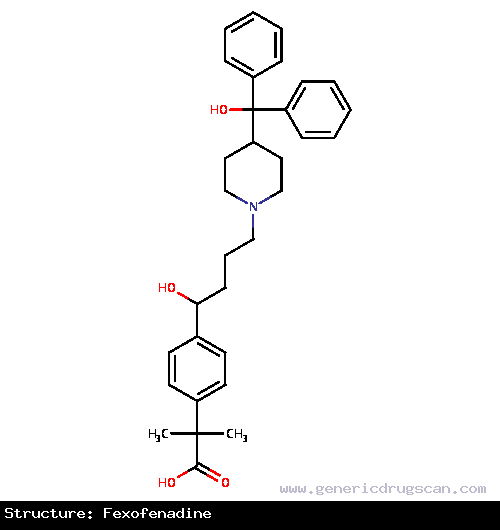Fexofenadine Drug: Indication, Dosage, Precaution, Side Effect , Storage, Category Type and corresponding Brands - www.genericdrugscan.com
Fexofenadine
Drug Status in USA : ApprovedDrug Status in Canada : Approved
pronunciation
pronounced as (fex oh fen' a deen)
Why is this medication prescribed?
Fexofenadine is used to relieve the allergy symptoms of seasonal allergic rhinitis (''hay fever''), including runny nose; sneezing; red, itchy, or watery eyes; or itching of the nose, throat, or roof of the mouth in adults and children 2 years of age and older. It is also used to relieve symptoms of urticaria (hives; red, itchy raised areas of the skin), including itching and rash in adults and children 6 months of age and older. Fexofenadine is in a class of medications called antihistamines. It works by blocking the effects of histamine, a substance in the body that causes allergy symptoms.
How should this medicine be used?
Fexofenadine comes as a tablet and a suspension (liquid) to take by mouth. It is usually taken with water once or twice a day. Fexofenadine will work better if it is not taken with fruit juices such as orange, grapefruit, or apple juice. Take fexofenadine at around the same time(s) every day. Follow the directions on your prescription label carefully, and ask your doctor or pharmacist to explain any part you do not understand. Take fexofenadine exactly as directed. Do not take more or less of it or take it more often than prescribed by your doctor.
Fexofenadine controls the symptoms of seasonal allergic rhinitis and urticaria but does not cure these conditions. Continue to take fexofenadine even if you feel well and are not experiencing these symptoms. If you wait too long between doses, your symptoms may become worse.
Shake the suspension well before each use to mix the medication evenly.
What are the precautions to be followed?
Before taking fexofenadine,- tell your doctor and pharmacist if you are allergic to fexofenadine, any other medications, or any of the ingredients in fexofenadine tablets or suspension. Ask your pharmacist for a list of the ingredients.
- tell your doctor and pharmacist what prescription and nonprescription medications, vitamins, nutritional supplements, and herbal products you are taking or plan to take. Be sure to mention either of the following: erythromycin (E.E.S., E-Mycin, Erythrocin) and ketoconazole (Nizoral). Your doctor may need to change the doses of your medications or monitor you carefully for side effects.
- if you are taking an antacid containing aluminum or magnesium (Maalox, Mylanta, others), take the antacid a few hours before or after fexofenadine.
- tell your doctor if you have or have ever had kidney disease.
- tell your doctor if you are pregnant, plan to become pregnant, or are breast-feeding. If you become pregnant while taking fexofenadine, call your doctor.
What are possible side effects of this medication ?
Fexofenadine may cause side effects. Tell your doctor if any of these symptoms are severe or do not go away:- headache
- dizziness
- diarrhea
- vomiting
- pain in the arms, legs, or back
- pain
- pain during menstrual period
- cough
- hives
- rash
- itching
- difficulty breathing or swallowing
- swelling of the face, throat, tongue, lips, eyes, hands, feet, ankles, or lower legs
- hoarseness
- difficulty swallowing or breathing
Fexofenadine may cause other side effects. Call your doctor if you have any unusual problems while taking this medication.
How to store the medication and dispose it of after its use later?
Keep this medication in the container it came in, tightly closed, and out of reach of children. Store it at room temperature and away from excess heat and moisture (not in the bathroom). Throw away any medication that is outdated or no longer needed. Talk to your pharmacist about the proper disposal of your medication.
Drug Category/Class
- Anti-Allergic Agents
- Histamine H1 Antagonists, Non-Sedating
- Histamine Antagonists
- Antihistamines for Systemic Use
- Respiratory System
- CYP2D6 Inducers
- CYP2D6 Inducers (strong)
- Other antihistamines for systemic use
| Prescribed | For management of Seasonal allergic rhinitis |
| Weight : | 501.6564 |
| Structure | Fexofenadine |
 | |
| Formula | C32H39NO4 |
Fexofenadine has 147 Brands listed
Search Generic Drugs alphabetically
